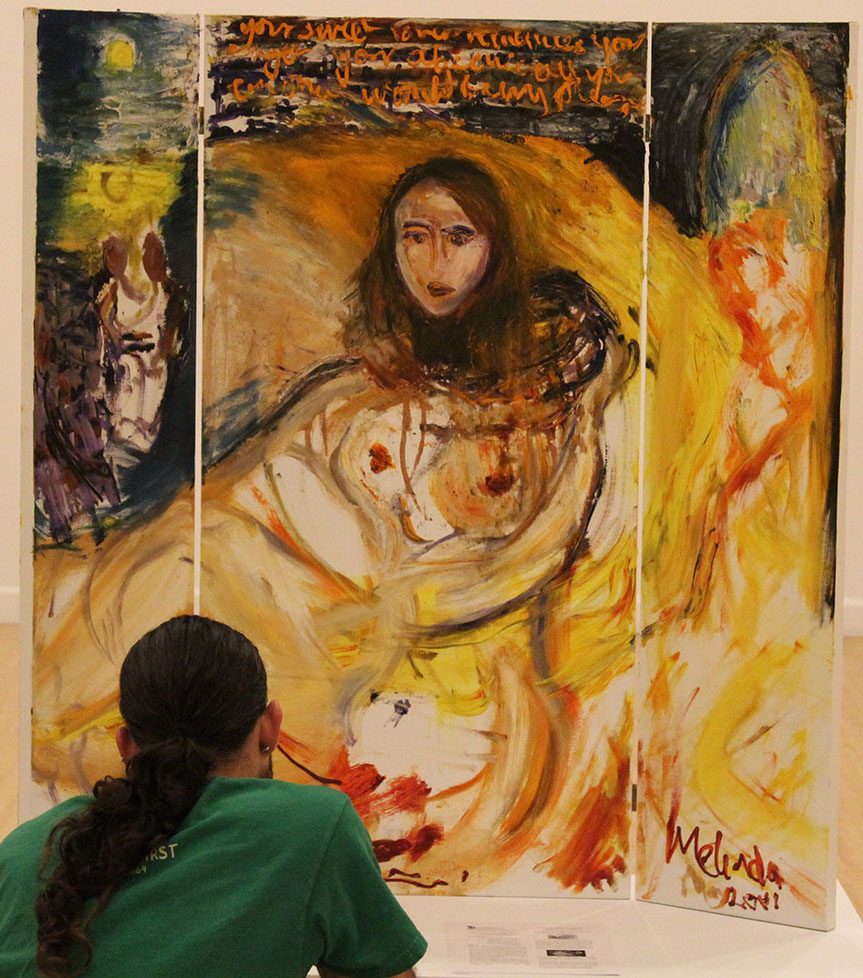
Artwork featuring circles of mourning displayed at campus art gallery
Dakota Days has brought many alumni into town, but not all came for the football game. On Friday and Saturday, art enthusiasts, alumni and students attended the reception for the exhibition of Melinda Camber Porter’s work in the John A. Day art gallery in the Fine Arts building.
Several distinguished alumni were at the reception, including Joseph Flicek, Porter’s widower. The exhibition has been open since Sept. 19, and is the first time all 90 watercolors from the Luminous Bodies series have been displayed in one place. Along with the watercolors is her oil-on-canvas series, The Triptychs.
Porter was born in England and attended Oxford University in London, later becoming a journalist for The Times, a London newspaper. In the 1970s, Porter moved to Paris, where she was the cultural correspondent for the Times.
While in Paris, Porter wrote a number of pieces about famous artists. She interviewed many famous people, including Nobel laureate and Mexican diplomat Octavio Paz.
The book “Melinda Camber Porter in Conversation with Octavio Paz” is coming out this November. Laura Vidler, the chair of USD’s modern language department, wrote a forward to the book.
“She was an incredibly interesting, incredibly creative and intelligent figure,” Vidler said. “Her work is so interdisciplinary… Because she was not just a journalist, she was also an artist herself, it kind of gave her an authority to speak with some of these people.”
After Paris, Porter moved to New York, where she married and raised two children. It was in New York that Porter created the art that is now on display in the John A. Day Gallery.
Luminous Bodies, the watercolor series, was created by Porter in the mid-1990s. The Triptych series of 27 oil-on-canvas paintings was made in 2001 and 2002.
In 2008, Porter died of ovarian cancer at the age of 55 in New York.
The Triptychs are oil-on-canvas paintings that are displayed in three parts. The word triptych is derived from the Greek for “three folds,” and is a popular style of painting. Each painting in The Triptychs series it made in this style and has three folds designed by master art framer, handler and installer James Lebron.
One of the triptychs on display is her 2001 painting “Ravages of War” which was made shortly after Sept. 11. The work features a frightened woman, representing Porter. “Ravages of War” is an expression of Porter’s fear in the aftermath of the attacks, which she witnessed as a resident of New York City at the time.
Another painting in The Triptychs is “The Triumph of Nature.” This painting is an example of Porter’s interdisciplinary skills as an artist. On all sides of this painting, like a majority of her work, there is poetry painted and written – with even words on the framing.
Luminous Bodies is based on the Tibetan book of death’s six circles of mourning. Porter lost a loved one in 1995, Flicek said, and each watercolor in the series represents a part of her mourning process.
In the Tibetan book of death, there are six circles of morning, and in the art gallery there are six alcoves displaying several watercolors, each alcove representing one of the six circles. Many of the watercolors also have poetry on them, like The Triptychs.
“I wanted to tell that journey, the journey about what our souls had done when we were in Paris, and the journey of what our souls did when he died,” said Porter in a previously taped interview on a website dedicated to her work. “I decided to note down in diary form what ever came to my mind during this journey.”
Flicek worked with USD’s art department to get the art displayed in the gallery. Flicek met the chair of USD’s art department at a USD Foundation fundraising event in New York. In December, Flicek came to USD to see the gallery for himself.
“The curator came out in February to New York, and she wanted the Triptychs and the Luminous Bodies series. And I said well, ‘Wow, if Melinda was alive, she would be so happy.’ And, what is really amazing about the John Day Gallery here is the fact that it’s big enough to show them all,” Flicek said. “Most places can’t show this. It’s an absolutely beautiful space, and these are moving walls, so I am absolutely thrilled by it.”
It took the curators two weeks to put the 90 Luminous Bodies along with some of the Triptychs on display in the gallery.
“It’s a lot of work but it is very rewarding when a lot of people come out to see it,” said Emily Short, the assistant curator at the gallery. “That’s the biggest reward is having people view the work and make use of the facilities.”
The art will be on display until Oct. 14. Melinda Camber Porter’s exhibition books, “The Triptychs,” “Luminous Bodies: Circles of Celebration,” “Melinda Camber Porter in Conversation with Octavio Paz” and “Luminous Bodies: Circles of Mourning,” will be sold in the university bookstore this November.

